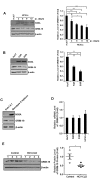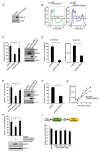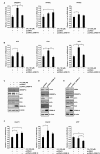GRIM-19 Restricts HCV Replication by Attenuating Intracellular Lipid Accumulation
- PMID: 28443075
- PMCID: PMC5387058
- DOI: 10.3389/fmicb.2017.00576
GRIM-19 Restricts HCV Replication by Attenuating Intracellular Lipid Accumulation
Abstract
Gene-associated with retinoid-interferon-induced mortality 19 (GRIM-19) targets multiple signaling pathways involved in cell death and growth. However, the role of GRIM-19 in the pathogenesis of hepatitis virus infections remains unexplored. Here, we investigated the restrictive effects of GRIM-19 on the replication of hepatitis C virus (HCV). We found that GRIM-19 protein levels were reduced in HCV-infected Huh7 cells and Huh7 cells harboring HCV replicons. Moreover, ectopically expressed GRIM-19 caused a reduction in both intracellular viral RNA levels and secreted viruses in HCVcc-infected cell cultures. The restrictive effect on HCV replication was restored by treatment with siRNA against GRIM-19. Interestingly, GRIM-19 overexpression did not alter the level of phosphorylated STAT3 or its subcellular distribution. Strikingly, forced expression of GRIM-19 attenuated an increase in intracellular lipid droplets after oleic acid (OA) treatment or HCVcc infection. GRIM-19 overexpression abrogated fatty acid-induced upregulation of sterol regulatory element-binding transcription factor-1 (SREBP-1c), resulting in attenuated expression of its target genes such as fatty acid synthase (FAS) and acetyl CoA carboxylase (ACC). Treatment with OA or overexpression of SREBP-1c in GRIM-19-expressing, HCVcc-infected cells restored HCV replication. Our results suggest that GRIM-19 interferes with HCV replication by attenuating intracellular lipid accumulation and therefore is an anti-viral host factor that could be a promising target for HCV treatment.
Keywords: anti-viral host factor; hepatitis C virus; intracellular lipid accumulation; lipogenesis; viral replication.
Figures







Similar articles
-
microRNA-99a Restricts Replication of Hepatitis C Virus by Targeting mTOR and de novo Lipogenesis.Viruses. 2020 Jun 27;12(7):696. doi: 10.3390/v12070696. Viruses. 2020. PMID: 32605105 Free PMC article.
-
Activation of sterol regulatory element-binding protein 1c and fatty acid synthase transcription by hepatitis C virus non-structural protein 2.J Gen Virol. 2008 May;89(Pt 5):1225-1230. doi: 10.1099/vir.0.83491-0. J Gen Virol. 2008. PMID: 18420801
-
[Inhibition of silent information regulator-1 in hepatocytes induces lipid metabolism disorders and enhances hepatitis C virus replication].Zhonghua Gan Zang Bing Za Zhi. 2013 Nov;21(11):834-9. doi: 10.3760/cma.j.issn.1007-3418.2013.11.009. Zhonghua Gan Zang Bing Za Zhi. 2013. PMID: 24331693 Chinese.
-
Complex lipid metabolic remodeling is required for efficient hepatitis C virus replication.Biochim Biophys Acta Mol Cell Biol Lipids. 2018 Sep;1863(9):1041-1056. doi: 10.1016/j.bbalip.2018.06.002. Epub 2018 Jun 6. Biochim Biophys Acta Mol Cell Biol Lipids. 2018. PMID: 29885363
-
[miR-122 participates in the cell tropism of hepatitis C virus].Uirusu. 2012 Jun;62(1):1-8. doi: 10.2222/jsv.62.1. Uirusu. 2012. PMID: 23189819 Review. Japanese.
Cited by
-
Role of SREBPs in Liver Diseases: A Mini-review.J Clin Transl Hepatol. 2018 Sep 28;6(3):332-338. doi: 10.14218/JCTH.2017.00061. Epub 2018 May 4. J Clin Transl Hepatol. 2018. PMID: 30271747 Free PMC article. Review.
-
GRIM19 Impedes Obesity by Regulating Inflammatory White Fat Browning and Promoting Th17/Treg Balance.Cells. 2021 Jan 15;10(1):162. doi: 10.3390/cells10010162. Cells. 2021. PMID: 33467683 Free PMC article.
-
Hijacking the Supplies: Metabolism as a Novel Facet of Virus-Host Interaction.Front Immunol. 2019 Jul 3;10:1533. doi: 10.3389/fimmu.2019.01533. eCollection 2019. Front Immunol. 2019. PMID: 31333664 Free PMC article. Review.
-
Serine Protease HtrA2/Omi Deficiency Impairs Mitochondrial Homeostasis and Promotes Hepatic Fibrogenesis via Activation of Hepatic Stellate Cells.Cells. 2019 Sep 20;8(10):1119. doi: 10.3390/cells8101119. Cells. 2019. PMID: 31547195 Free PMC article.
References
-
- Angell J. E., Lindner D. J., Shapiro P. S., Hofmann E. R., Kalvakolanu D. V. (2000). Identification of GRIM-19, a novel cell death-regulatory gene induced by the interferon-beta and retinoic acid combination, using a genetic approach. J. Biol. Chem. 275 33416–33426. 10.1074/jbc.M003929200 - DOI - PubMed
LinkOut - more resources
Full Text Sources
Other Literature Sources
Research Materials
Miscellaneous

